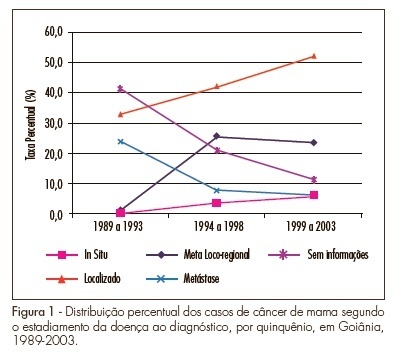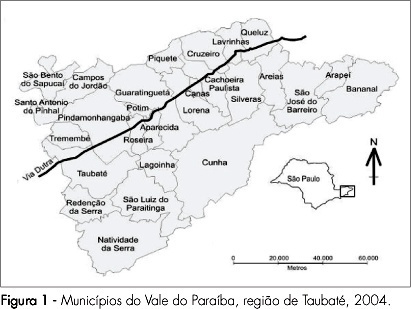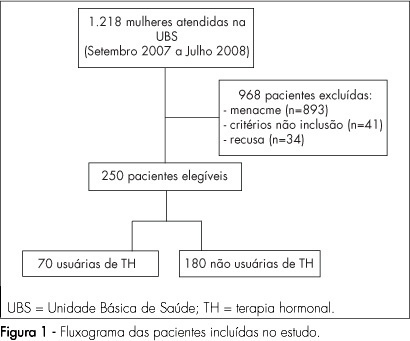Summary
Revista Brasileira de Ginecologia e Obstetrícia. 2009;31(5):224-229
DOI 10.1590/S0100-72032009000500004
PURPOSE: to identify the pattern of myoelectrical activity of muscles from the scapular region, after axillary lymphadenectomy in breast cancer. METHODS: prospective cohort study including all the women submitted to axillary lymphadenectomy for surgical treatment of breast cancer, in a breast cancer reference center, from June to August 2006. The women were evaluated before, and after 3 and 12 months from the surgery, through physical and electromyographic examinations of the serratus anterior, upper trapezius and middle deltoid muscles. RESULTS: the patients' average age was 60.3 years old (DP±14.1), and the incidence of winged scapula at the physical examination was 64.9%. At the third-months evaluation, a reduction of 28.3 µV was observed in the myoelectrical activity of the serratus anterior muscle. At the twelveth-months evaluation and between the 3rd and the 12th month, there was an increment of 23.3 µV and 43.6 µV, respectively. For the upper trapezius, the increase was of 23.1 µV at the third-months evaluation, and 23.3 µV and 43.6 µV between the 3rd and the 12th months. As compared to before the surgery, the evaluation of the middle deltoid muscle did no present significant differences. CONCLUSIONS: considering muscle activity evaluated by surface electromyography, there was a decrease in the myoelectrical activity of the serratus anterior, due to lesion of the long thoracic nerve (neuropraxia), in the immediate postoperative evaluation. The increase of the mean square root of the electromyographic signal of the upper trapezius muscle, since the preoperative evaluation, suggests a muscular compensation related to the serratus anterior muscle's deficit.
Summary
Revista Brasileira de Ginecologia e Obstetrícia. 2009;31(5):219-223
DOI 10.1590/S0100-72032009000500003
PURPOSE: To analyze the temporal changes of breast cancer staging at diagnosis among women living in Goiânia, Goiás, Brazil, between 1989 and 2003. METHODS: Retrospective and descriptive study in which the cases were identified from the Population-Based Cancer Registry of Goiânia for the period from 1989 to 2003. The variables studied were age, diagnostic method, topographic sublocation, morphology and breast cancer staging. Frequency analyses were carried out on the variables and means, and the medians for the age were determined. The SPSS® 15.0 software was used for statistical analyses. RESULTS: A total of 3,204 breast cancer cases were collected. The mean age was 56 years (sd±16 years). With regard to clinical staging, 45.6% of the cases were found to be localized in the breast, with an increased rate of 19.25% between the first and the third five-year period (p<0.001; CI 95%=0.14-0.23) and 10.2% of cases were with distant metastases. However, a reduction of 17.74% for metastatic cases in the same interval (p<0.001 e CI 95%=0.14-21) was observed. The in situ case rate was 0.2% in 1989-1993 and increased to 6.2% in 1999-2003 (p<0.001, IC95%=4.9-7.4). CONCLUSION: The diagnostic profile of breast cancer in the city of Goiânia is changing. Substantial increases in the number of early breast cancer cases are being found in relation to the number of advanced cases.

Summary
Revista Brasileira de Ginecologia e Obstetrícia. 2009;31(3)
Summary
Revista Brasileira de Ginecologia e Obstetrícia. 2009;31(4):171-176
DOI 10.1590/S0100-72032009000400003
PURPOSE: to apply geoprocessing techniques for the spatial birth profile analysis of each municipality. METHODS: ecological and exploratory study, using data from the Health Information System about born alive babies in 2004, and using geoprocessing techniques. The spatial autocorrelations of the variables: cesarean section, mother's schooling, low birth weight, Apgar score at five minutes, prematurity, number of medical appointments and adolescent mothers, besides the map with the index of human development were estimated. For the detection of spatial events aggregates, Moran's I M statistics, through the program Terra View 3.13 (developed by INPE and available to the public) was used. Spatial maps with those variables were built, and Pearson's correlation coefficients, estimated. RESULTS: results have shown that the rate of born alive babies, from mothers with school level over primary school and from cesarean sections, presented a spatial pattern visually identifiable and significant spatial self-correlation. Low birth weight, prematurity, Apgar score, number of pre-natal appointments and adolescent mothers have presented a random spatial pattern, showing that, in this analysis scale, those markers have not discriminated the risk groups, despite their unquestionable predictive value for children's morbidity-mortality at individual level. There has been a positive correlation between cesarean section and schooling, and between cesarean section and human development index; and a negative correlation between adolescent mothers and human development index, with statistical significance (p<0.05). CONCLUSIONS: this methodology has allowed us to identify spatial clusters for the variables cesarean section and mother's schooling, besides deepening our knowledge on birth profile in the municipalities, presenting good potential on how to direct actions for specific areas.

Summary
Revista Brasileira de Ginecologia e Obstetrícia. 2009;31(4):164-170
DOI 10.1590/S0100-72032009000400002
PURPOSE: to determine factors associated to amniotic fluid volume and frequencies of fetal anomalies, in a reference center in Pernambuco. METHODS: a transversal study performed in high-risk pregnant women submitted to obstetrical morphological ultrasound, from March 2002 to March 2006, at an institution from Recife, Pernambuco, Brasil. The intrauterine diagnosis was confirmed after birth. Sociodemographic and obstetrical characteristics, amniotic liquid volume and presence of fetal anomalies were the variables studied. Fisher's exact, χ2, and Student's t tests, at a significance level of 5% were applied to verify the correlation among the variables. Prevalence rate and confidence interval at 95% were calculated. Multiple logistic regression analysis was performed at a significance level of 5%. RESULTS: Two hundred and fifty-seven pregnant women (56.2%) with congenital anomalies and 200 (43.8%) without anomalies, confirmed in the postnatal, were included in the study. The average of maternal ages and gestation periods were 24.8±6.5 years and 35.9±3.7 weeks, respectively. The fetal anomalies were discovered in the central nervous system (50.6%) and genitourinary tract (23.0%). The presence of congenital anomalies were significantly linked with reduced liquid/oligohydramnios (p=0.0002) and increased liquid/polyhydramnios (p<0.0001). Intrauterine mortality was more frequent in the group with anomalies, as compared to the healthy fetuses (10.5 versus 2.5%; p<0.01). CONCLUSIONS: The rate of congenital anomalies in the high-risk pregnant women group was 56.2%. Most of the central nervous system malformations were diagnosed intrauterus. Changes in the amniotic fluid were the factors more strongly associated with congenital anomalies.
Summary
Revista Brasileira de Ginecologia e Obstetrícia. 2009;31(4):196-202
DOI 10.1590/S0100-72032009000400007
PURPOSE: to evaluate the quality of life of post-menopause women, users and non-users of hormonal therapy (HT), in a Healthcare Unit in Franca, São Paulo, Brazil. METHODS: a clinical transversal study, carried out with 250 post-menopausal women, with ages from 45 to 70 years old, attended to in Healthcare Units, from September 2007 to August 2008. Participants were divided into two groups: HT users (n=70) and non-users (n=180). Women making continuous HT use for at least six months were considered as users. Sociodemographic and clinical characteristics have been evaluated. Blatt-Kupperman's menopausal index has been applied to assess climacteric symptoms, and the Women's Health Questionnaire (WHQ), to assess their quality of life. Fisher's exact test or χ2 and Mann-Whitney and Kruskal-Wallis's tests have been used for the statistical analysis. RESULTS: no significant difference has been found in the comparison of groups, concerning age, menarche, menopause, parity and body mass index. It has been seen that 67.2% of the women were married, 83.2% had attended primary school and 53.2% were housewives, with no difference between the groups. HT users reported lower frequency of climacteric symptoms (BKMI) with moderate and marked intensity, as compared to non-users (p<0.001). Even though HT users presented lower average score in cognitive deficit (p<0.001), vasomotor symptoms (p=0.04), sleeping problems (p<0.001), attractiveness (p=0.02) from the WHQ, there has been no difference in the total score, as compared to non-users. CONCLUSIONS: post-menopausal women, HT users and non-users, admitted at Healthcare Units, have not presented differences in global quality of life.

Summary
Revista Brasileira de Ginecologia e Obstetrícia. 2009;31(4):189-195
DOI 10.1590/S0100-72032009000400006
PURPOSE: to identify species of lactobacillus isolated from the vaginal contents of healthy and asymptomatic women, determining the most prevalent species and characterizing them phenotypically. METHODS: lactobacillus have been isolated in selective milieu from samples of the vaginal contents of 135 women without complaints of vaginal secretion, and with negative laboratorial diagnosis of vaginal infection, followed up at an outpatient clinic. After being identified by multiplex PCR, the isolates have been submitted to RNAr 16S gene sequencing, when necessary. They have also been evaluated concerning the production of lactic acid, H2O2, bacteriocins and the ability to adhere to epithelial cells. RESULTS: eight-three lactobacillus strains were isolated and identified, L. crispatus (30.1%), L. jensenii (26.5%), L. gasseri (22.9%) e L. vaginalis (8.4%), being the prevalent species. Only 20 of those isolates did not present H2O2 production, in detectable amounts. From the 37 strains selected for the test of adhesion to the epithelial cells, 12 presented 50 to 69% of adhesion, 10 presented 70% or more, and the remaining, little or no adhesion at all. None of the tested strains produced bacteriocins. CONCLUSIONS: the lactobacillus species more prevalent in women without vulvovaginitis, isolated in selective culture milieu and identified by molecular methods were L. crispatus, L. jensenii and L. gasseri. Besides the fact of being more prevalent, these strains also presented better production of H2O2, and reached lower pH values in the culture milieu.
Summary
Revista Brasileira de Ginecologia e Obstetrícia. 2009;31(4):182-188
DOI 10.1590/S0100-72032009000400005
PURPOSE: to observe the impact of obesity and other risk factors on the rate of failure in patients submitted to Burch's surgery for the treatment of urinary incontinence. METHODS: cases study of patients submitted to Burch's surgery, from 1992 to 2003. Patients were evaluated at the second post-surgery appointment (average 66 days) and after one-year follow-up, and classified in two groups: Continent and Non-continent. Variables analyzed were: age, parity, body mass index (BMI), menopause duration, duration of hormonal therapy, urodynamic evaluation, history of urinary tract infection, previous urinary incontinence surgery, diabetes, cystocele and uterine prolapse, time spent in hospital, necessity of self-probing, post-surgical spontaneous micturition, and surgical wound. Data were analyzed with the Statistical Package for Social Sciences 14.0 statistical package. For the comparison of continuous variables, Student's t-test or Mann-Whitney test were used, and Fisher exact and χ2 tests, for the categorical variables (p<0.05). RESULTS: at the second post-surgical evaluation, there was no significant difference between the two groups, concerning the variables analyzed. After one-year follow-up, from a total of 97 patients, 81 were continent and 16, non-continent, BMI and height being different between the groups. In the continent group, average BMI was 27.1 and height, 1.57 m, and, among the non-continent, 30.8 (p=0.02) and 1.52 m (p=0.01). The BMI>30 Odds Ratio was 3.7 (CI95%=1.2-11.5). CONCLUSIONS: obesity has shown to be an important risk factor for the surgery failure in the first follow-up year. Results show that patients with BMI>30 have 3.7 times more chance of being non-continent one-year after Burch's surgery than non-obese patients.